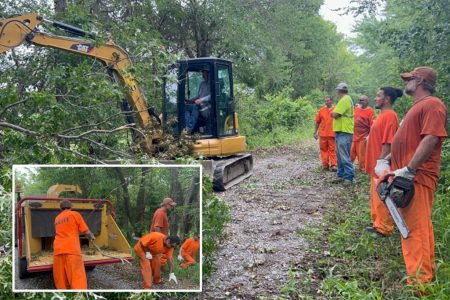The coastal city of Maricá, Brazil, plunged into mourning after a catastrophic incident involving the city’s iconic floating Christmas tree claimed the life of a young worker and injured two others. The 184-foot tall structure, a beacon of holiday cheer and a major tourist attraction, was in the final stages of assembly in the Lagoa de Aractiba when a sudden, violent thunderstorm swept through the area. The towering display, adorned with 360,000 lights and poised to illuminate the festive season, buckled under the force of the gale-force winds, collapsing into the lagoon just days before its scheduled unveiling.
The unfolding tragedy sent shockwaves through the community as bystanders and fellow workers watched in horror. The massive structure, a symbol of joy and celebration, crumbled near the shore, scattering debris across the water’s surface. Frantic rescue efforts were immediately launched, with people rushing to the nearest dock in a desperate attempt to save those caught in the wreckage. Two workers were pulled from the debris and rushed to a local hospital for treatment. However, despite the valiant efforts, one worker, 21-year-old Vinicius dos Santos Abreu, a resident of Maricá, succumbed to his injuries.
The tragic incident cast a long shadow over the festive preparations in Maricá. Mayor Fabiano Horta expressed his profound sorrow and condolences to the family of the deceased worker, announcing two days of official mourning for the city. All scheduled Christmas light programming and festivities were suspended until Thursday as a mark of respect for the young life lost and the trauma experienced by the community. The vibrant city, usually bustling with holiday cheer, was enveloped in a somber atmosphere as residents grappled with the sudden loss and the stark reminder of the power of nature.
The devastating collapse has prompted a thorough investigation into the circumstances surrounding the incident. While the sudden and intense nature of the thunderstorm played a significant role, authorities are examining all aspects of the tragedy, including the structural integrity of the tree, the safety protocols in place, and the decision-making process leading up to the ill-fated assembly. Civil Defense officials had issued a storm warning prior to the incident, and the crew responsible for assembling the tree had begun evacuation procedures. However, the rapidity with which the storm intensified tragically outpaced their efforts, leaving them vulnerable to the devastating force of nature.
The incident underscores the inherent risks associated with large-scale installations, particularly in exposed environments susceptible to sudden weather changes. The floating Christmas tree, a symbol of community pride and festive spirit, became a stark reminder of the unpredictable and often unforgiving power of nature. The investigation will likely focus on determining whether all necessary precautions were taken in light of the impending storm warning and whether the evacuation procedures were adequately robust to ensure the safety of the workers. The findings of the investigation will be crucial in preventing similar tragedies in the future.
The tragedy in Maricá serves as a poignant reminder of the fragility of life and the importance of prioritizing safety, especially in the face of unpredictable weather conditions. As the community mourns the loss of a young life, the incident prompts reflection on the balance between creating spectacular displays and ensuring the safety of those involved in their construction. The festive season, often associated with joy and celebration, has been tinged with sorrow and loss, leaving a lasting impact on the city of Maricá. The memory of Vinicius dos Santos Abreu will undoubtedly serve as a catalyst for enhanced safety measures in future events, ensuring that such a tragedy is never repeated.










